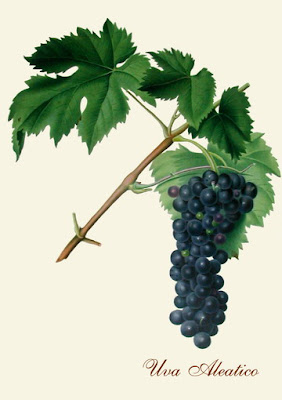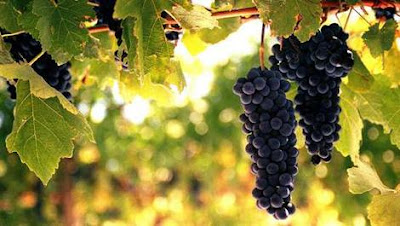 Shiraz (shi-rahz) comes from the Hermitage area of the Rhone Valley in France, where it is known as Syrah. One tradition suggests that it was brought to Hermitage from Shiraz in Iran by the hermits, another that it was brought from Syracuse by the Roman legions, but it seems quite likely that it originated in the Rhone Valley. It is sometimes called Hermitage in Australia, but should not be confused with the Hermitage of South Africa which is really Cinsaut. The Petite Sirah of California is a different variety, Durif, which comes from the same part of France where it has occasionally been incorrectly called Petite Syrah. There was a dramatic increase in the area planted to Syrah in France between 1968 and 1988, mainly to add character to wines based on Grenache or Carignan. Australia currently has more than 37 000 ha of this variety in production. A little is grown in Tuscany in Italy and some in Argentina and South Africa.
Shiraz (shi-rahz) comes from the Hermitage area of the Rhone Valley in France, where it is known as Syrah. One tradition suggests that it was brought to Hermitage from Shiraz in Iran by the hermits, another that it was brought from Syracuse by the Roman legions, but it seems quite likely that it originated in the Rhone Valley. It is sometimes called Hermitage in Australia, but should not be confused with the Hermitage of South Africa which is really Cinsaut. The Petite Sirah of California is a different variety, Durif, which comes from the same part of France where it has occasionally been incorrectly called Petite Syrah. There was a dramatic increase in the area planted to Syrah in France between 1968 and 1988, mainly to add character to wines based on Grenache or Carignan. Australia currently has more than 37 000 ha of this variety in production. A little is grown in Tuscany in Italy and some in Argentina and South Africa.
Saturday, 31 October 2009
Shiraz
 Shiraz (shi-rahz) comes from the Hermitage area of the Rhone Valley in France, where it is known as Syrah. One tradition suggests that it was brought to Hermitage from Shiraz in Iran by the hermits, another that it was brought from Syracuse by the Roman legions, but it seems quite likely that it originated in the Rhone Valley. It is sometimes called Hermitage in Australia, but should not be confused with the Hermitage of South Africa which is really Cinsaut. The Petite Sirah of California is a different variety, Durif, which comes from the same part of France where it has occasionally been incorrectly called Petite Syrah. There was a dramatic increase in the area planted to Syrah in France between 1968 and 1988, mainly to add character to wines based on Grenache or Carignan. Australia currently has more than 37 000 ha of this variety in production. A little is grown in Tuscany in Italy and some in Argentina and South Africa.
Shiraz (shi-rahz) comes from the Hermitage area of the Rhone Valley in France, where it is known as Syrah. One tradition suggests that it was brought to Hermitage from Shiraz in Iran by the hermits, another that it was brought from Syracuse by the Roman legions, but it seems quite likely that it originated in the Rhone Valley. It is sometimes called Hermitage in Australia, but should not be confused with the Hermitage of South Africa which is really Cinsaut. The Petite Sirah of California is a different variety, Durif, which comes from the same part of France where it has occasionally been incorrectly called Petite Syrah. There was a dramatic increase in the area planted to Syrah in France between 1968 and 1988, mainly to add character to wines based on Grenache or Carignan. Australia currently has more than 37 000 ha of this variety in production. A little is grown in Tuscany in Italy and some in Argentina and South Africa.
Friday, 30 October 2009
Wines of Valdiguie grape
In France, Valdiguie gives red wines which are regarded as common and uninteresting. They have good colour but are lacking in alcohol and flavour. However, in California it is esteemed for the production of both red and rosé wines.Wines made at Merbein have scored well in blind tastings.
Thursday, 29 October 2009
Aleatico wine grape
In Italy, Aleatico is used to make a highly regarded sweet, ruby coloured, muscat wine. Aleatico can be used to make white wines and fortified wines and could be tried as a substitute for Muscat à
petits grains where there are problems with that variety.
Wednesday, 28 October 2009
Wines from Barbera
Wines from Barbera have good colour, tannin and acidity, and a distinctive varietal character which may not be immediately acceptable to Australian wine-drinkers.When aged in oak the wines can be complex and full-bodied with a delicate bouquet. In Italy it is
mostly used for making full-flavoured dry red wines with earthy character, soft tannin and ripe currant flavour, but sweet red and sparkling red wines are also made from it.
mostly used for making full-flavoured dry red wines with earthy character, soft tannin and ripe currant flavour, but sweet red and sparkling red wines are also made from it.
Tuesday, 27 October 2009
Bastardo port variates
Under most Australian conditions this potentially sweet, full wine is best suited
for fortified wines. The fruit ripens early and attains a high sugar concentration,
which increases even further as the berries wilt. It does not provide much colour in the wine but will combine with other varieties that provide colour and flavour. Bastardo.
for fortified wines. The fruit ripens early and attains a high sugar concentration,
which increases even further as the berries wilt. It does not provide much colour in the wine but will combine with other varieties that provide colour and flavour. Bastardo.
Monday, 26 October 2009
Wine Biancone
Biancone with its high yields has little character, and this soft and fruity wine is
mainly used for distillation or bulk production in the Riverland. There is some evidence that it can produce a distinctive dry white wine in cooler areas.
mainly used for distillation or bulk production in the Riverland. There is some evidence that it can produce a distinctive dry white wine in cooler areas.
Sunday, 25 October 2009
Zinfandel grape
Zinfandel should give spicy, fullbodied red wines of a bright colour and distinctive varietal character. In California it is recommended that such wines not be blended. Its strong raspberry flavour can sometimes be overpowering to people unaccustomed to the style.
Saturday, 24 October 2009
Characteristics of the Viognier
Viognier has not been grown extensively in Australia but there has been an increase in interest in this white grape variety and there are currently 541 ha. With its distinctive aroma of dried apricots the wine could be useful as a specialty line in some of the cooler regions of Australia. It has been used to produce a full-bodied sweet white wine in some of the warmer regions of the country with some success.
Friday, 23 October 2009
Cabernet Sauvignon

Cabernet Sauvignon (ka-ber-nay so-vinyohn) comes from the Bordeaux region of France and is the major variety in some of the best wines of the Medoc area. It is also prominent in Chile and
has increased rapidly in recent years in California (30 754 ha in 2002), Australia (28 871 ha in 2003) and South Africa. In Italy it is a minor variety recommended only in the extreme north. It is probably more important in eastern Europe and Argentina.
Thursday, 22 October 2009
Cabernet Franc

Cabernet Franc (ka-ber-nay frahnk) is an important variety of the Bordeaux area of France.There have been small plantings in recent years, but Cabernet Franc generally occurs in Australia as odd vines in plantings of Cabernet Sauvignon, particularly in north-east Victoria where it sometimes occurs to the extent of more than one vine in ten. In France, it is also
grown in the Loire Valley and is now recommended throughout the entire south, including Corsica. In Italy it is regarded more highly than Cabernet Sauvignon and recommended in more
provinces. The Cabernet varieties, particularly Cabernet Sauvignon, are important in eastern Europe and South America but they are not always recorded separately. Cabernet Franc, with 1427 ha recorded in 2002, has not achieved the same recognition as Cabernet Sauvignon
in California. 834 ha of this variety were harvested in Australia in 2003.
Wednesday, 21 October 2009
Bourboulenc
 Bourboulenc (bor-buh-lahnk) is a recommended variety throughout Mediterranean France and is found mainly in the lower valley of the Rhone. It is an approved variety for wines of controlled appellation such as Chateauneuf-du-Pape and Cotes du Rhone. It appears four times, under different names, among Busby’s imports into Australia in 1832, but has not survived in any of the official viticultural collections. It is found only as odd vines in old vineyards in Great Western and Rutherglen and possibly elsewhere.
Bourboulenc (bor-buh-lahnk) is a recommended variety throughout Mediterranean France and is found mainly in the lower valley of the Rhone. It is an approved variety for wines of controlled appellation such as Chateauneuf-du-Pape and Cotes du Rhone. It appears four times, under different names, among Busby’s imports into Australia in 1832, but has not survived in any of the official viticultural collections. It is found only as odd vines in old vineyards in Great Western and Rutherglen and possibly elsewhere.
Tuesday, 20 October 2009
Terrets
Terrets (te-ret) are old recommended varieties from the Languedoc area in the south of France.Three colour variants are known – Terret Blanc (white), Terret Gris (grey) and Terret Noir (black) – and chimeras are sometimes seen in all combinations. In Australia there is a small area of Terret Noir in the Barossa Valley.
Monday, 19 October 2009
Tinta Amarella

Tinta Amarella (teen-tah am-ah-rel-ah) is best known as a port variety. It is widely
grown in the Douro Valley, where it is regarded as a good – rather than very good – variety. It seems to be little grown outside Portugal, but is distinctly different from the other common port varieties and it is thought that it may have come from France. It could perhaps have been the Amarot of Landes, listed among Busby’s imports into Australia. The small plantings in Australia are all in South Australia, where this red grape variety is known as Portugal. It is not uncommon as odd vines in plantings of other varieties and this seems to have led to confusion with Malbec: some intended plantings of Malbec have actually been planted with Tinta Amarella.
Sunday, 18 October 2009
Tocai Friulano

Tocai Friulano (toh-kay frih-uh-lah-noh) probably originated in France, where it is known as Sauvignonasse, and appears to be related to Sauvignon Blanc. However, it would seem more appropriate to use the Italian name of Tocai Friulano, because the variety has almost disappeared from France yet has become very popular in the Friuli-Venezia Giulia region of Italy, where several thousand hectares are planted.Tocai Friulano is also the preferred name in Argentina. In Chile it has been erroneously called Sauvignon. It is widespread in Australia, but only in plantings of other varieties in Mudgee, the Goulburn Valley and Great Western.
Saturday, 17 October 2009
Touriga Nacional
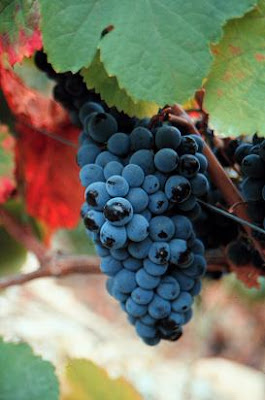
Touriga Nacional (too-ree-gah nah-syunahl) is the most widely planted of the top-quality group of port varieties in the Douro Valley in Portugal. This red grape variety is also grown in other parts of Portugal for other types of wine, but there seems to be very little outside Portugal. There are a few hectares in California and it is probably one of the ‘port sorts’ in South Africa. There is a small amount of Touriga in Australia (82 ha), mostly in South Australia.
Friday, 16 October 2009
Traminer

Traminer (tram-ih-nher or trah-mee-nher) is another old white grape variety showing primitive characters. It is valued mainly for its strong aromatic character in making white wine and, as there are large clonal differences in this respect, the more
aromatic clones are sometimes distinguished as Gewürztraminer. Being a specialised variety, it is not required in large quantities and thus there are modest plantings in Germany, Austria, France and California. The variety has been in Australia for a long time but only in relatively small quantities (673 ha in 2003).
Thursday, 15 October 2009
Trebbiano
Trebbiano (treb-ih-yahn-oh) is the Italian name of this white grape variety; it is
more specifically known as Trebbiano Toscano to distinguish it from several similar varieties also known as Trebbiano. It is by far the leading grape for producing white wine in Italy, probably because it ripens reliably in most areas of the country – it has no other distinguishing characteristics. It spread into the south of France and from there into the Cognac area when a new variety was needed to take the place of Folle Blanche, which suffers from bunch rot when grafted.The official French name is Ugni Blanc but in the Cognac area it is known as Saint Emilion. In South Africa, California and Argentina it is a minor variety. In Australia there are about 490 ha. It has sometimes been known as White Shiraz or White Hermitage, but it does not appear to be in any way related to Shiraz and is not grown in the Hermitage vineyards in France.
more specifically known as Trebbiano Toscano to distinguish it from several similar varieties also known as Trebbiano. It is by far the leading grape for producing white wine in Italy, probably because it ripens reliably in most areas of the country – it has no other distinguishing characteristics. It spread into the south of France and from there into the Cognac area when a new variety was needed to take the place of Folle Blanche, which suffers from bunch rot when grafted.The official French name is Ugni Blanc but in the Cognac area it is known as Saint Emilion. In South Africa, California and Argentina it is a minor variety. In Australia there are about 490 ha. It has sometimes been known as White Shiraz or White Hermitage, but it does not appear to be in any way related to Shiraz and is not grown in the Hermitage vineyards in France.
Wednesday, 14 October 2009
Tyrian grape
Tyrian (tih-rih-an) is the product of a cross between the Spanish wine variety Sumoll
and Cabernet Sauvignon. The original pollination was made in 1972 by the late Allan Antcliff at the CSIRO Merbein laboratory. The aim of the program was to produce high-quality red wine grapes suited to Australian conditions. Extensive evaluations were made of Tyrian, Ciena and Rubienne in three wine-growing regions; Coonawarra (South Australia), Avoca (central Victoria) and Sunraysia (northern Victoria).
and Cabernet Sauvignon. The original pollination was made in 1972 by the late Allan Antcliff at the CSIRO Merbein laboratory. The aim of the program was to produce high-quality red wine grapes suited to Australian conditions. Extensive evaluations were made of Tyrian, Ciena and Rubienne in three wine-growing regions; Coonawarra (South Australia), Avoca (central Victoria) and Sunraysia (northern Victoria).
Tuesday, 13 October 2009
Fortified wines Verdelho
In Portugal Verdelho is used for fortified wines, in white port and as the predominant variety in one of the four types of Madeira. In France it is used for dry white table wine. In Australia it is generally used for white table wines and shows a strong and attractive varietal character with a delicate nutty bouquet. The wines can be golden coloured and have distinctive tannin on the palate.
Wines made from Bonvedro
Wines made from Bonvedro in Australia have a pleasant varietal character but are soft and lacking in tannin, and in the past were unfavourably compared with other varieties of wine with more colour and tannin. Increasing interest in lighter red wines may encourage a reappraisal of this position.
Alvarelhao - port varieties
Alvarelhao is lower in colour and tannin than the other port varieties and although widely planted in Portugal, does seem to be more suitable for red wine rather than port. It has been reported as producing red wines with good acidity and balance.
Monday, 12 October 2009
Valdiguie
Sunday, 11 October 2009
Verdelho
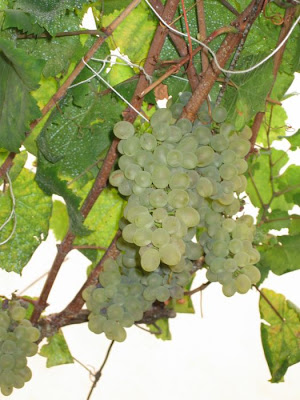
Verdelho (vehr-del-oh) is a Portuguese variety grown on the island of Madeira and in the Douro Valley, where it is known as Gouveio. There are also some small plantings in the Loire Valley in France. In Australia there are small plantings in Western Australia, South Australia and New South Wales, with a total planted area of around1600 ha.The name Madeira has sometimes been used for the variety in New South Wales, a possible source of confusion because the same name was erroneously used for some of the Semillon in South Australia.
Friday, 9 October 2009
Bonvedro
Bonvedro (bon-ved-roh) is the Portuguese name of this variety, which is also grown in north-eastern Spain as Cuatendra. It possibly also occurred in France as an obscure variety and may have arrived in Australia as part of a large collection, such as Busby’s. In this way it could have become confused with Carignan, the name generally used for Bonvedro in Australia.There may also have been confusion with another variety from north-eastern Spain, Miguel de Arco, as the vines grown under this name in Australia also seem to be Bonvedro. Small quantities of Bonvedro are grown in Australia, mostly in South Australia and a little in New South Wales and Victoria.
Thursday, 8 October 2009
Biancone

Biancone (bee-yan-kowhn) has the distinction of giving the highest commercial yield of any variety in Australia. Almost all is grown in the Riverland of South Australia. The variety comes from Corsica, where its excellent production has led to one of its names being Pagadebiti, literally ‘payer of debts’. Small areas of Biancone have been grown under the name of Grenache Blanc Productif and it was probably imported into Australia under this name.The Biancone of the island of Elba is thought to be the same variety but it does not appear to have become established in any other countries.
Wednesday, 7 October 2009
Bianco d’Alessano

Bianco d’Alessano (be-ank-oh dal-essah-noh) is a late-ripening white wine grape variety from the Puglia region of south-east Italy with substantial plantings in the province of Taranto near Bari. Bianco d’Alessano produces yields of about 30 tonnes/ha in the warm irrigated regions of Australia. The juice is sweet and neutral in flavour.
Monday, 5 October 2009
Bastardo
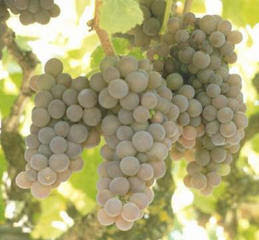 Bastardo (bas-tah-doh) is considered one of the better port varieties in Portugal, although it is not as widely grown as Touriga or Tinta Amarella. It is also grown under the name of Trousseau in the Jura region in eastern France. It is probably one of the ‘port sorts’ in South Africa and there may be a little in California and South America, but not enough to be recorded separately. The exact area of planting in Australia is uncertain. There is a small quantity in South Australia as Cabernet Gros, a little in north-east Victoria and nearby in New South Wales called Bastardo. Some plantings called Touriga in New South Wales are also Bastardo.
Bastardo (bas-tah-doh) is considered one of the better port varieties in Portugal, although it is not as widely grown as Touriga or Tinta Amarella. It is also grown under the name of Trousseau in the Jura region in eastern France. It is probably one of the ‘port sorts’ in South Africa and there may be a little in California and South America, but not enough to be recorded separately. The exact area of planting in Australia is uncertain. There is a small quantity in South Australia as Cabernet Gros, a little in north-east Victoria and nearby in New South Wales called Bastardo. Some plantings called Touriga in New South Wales are also Bastardo.
Viognier

Viognier (vih-onyay) is an old variety restricted to the right bank of the Rhone River south of Vienne in France. In the appellation Cote-Rotie it is blended with Shiraz to add perfume to the red wine, but in Condrieu it is vintaged alone to make a dry white wine with a floral scent and a long spicy aftertaste. Chateau Grillet, at the centre of Condrieu, with its 1.6 ha of Viognier, is the smallest vineyard with its own appellation in France – and one of the most famous.
Zinfandel

Zinfandel (zihn-fahn-del) is the Californian name for this variety, where in 2003 it was the third most widely planted red wine grape after Cabernet Sauvignon and Merlot. It does far better in warmer regions where it ripens well, and is also becoming established in Australia, South Africa and South America. It has now been confirmed that it is the Italian variety Primitivo, which is grown quite extensively in the province of Taranto. It is also grown in the Dalmatian region of Yugoslavia under the name of Plavac Veliki.
Barbera

Barbera (bar-beer-ah) is the leading wine grape of Italy, grown mainly in Piedmont. It is used in wines of controlled appellation, sometimes alone and sometimes mixed with other varieties. Argentina grows some Barbera. It was popular in California in the 1970s, reaching 8600 ha in 1977, with around 4000 ha currently. There are 141 ha of Barbera planted in Australia.
Sunday, 4 October 2009
Alvarelhao
Alvarelhao (ahl-vah-rel-oh) was recommended, along with Bastardo and Touriga, by Mr F. de Castella, former Government Viticulturist in Victoria, for the production of port. However, in the variety classification used in the Douro Valley in Portugal, Bastardo and Touriga are rated as very good but Alvarelhao is rated as only reasonable. So it is perhaps not surprising that less Alvarelhao than Touriga and Bastardo has been planted in Australia, with a few small plantings in north-east Victoria and southern New South Wales only.There appears to be very little of this variety grown outside Portugal. It is not clear whether it is present in California, as the variety imported from there as Alvarelhao proved to be actually Touriga.
Friday, 2 October 2009
Aleatico
Subscribe to:
Comments (Atom)

